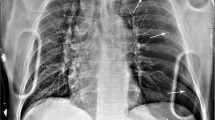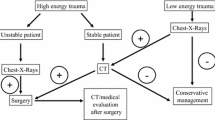Abstract
In the setting of acute trauma where identification of critical injuries is time-sensitive, a portable chest radiograph is broadly accepted as an initial diagnostic test for identifying benign and life-threatening pathologies and guiding further imaging and interventions. This article describes chest radiographic findings associated with various injuries resulting from blunt chest trauma and compares the efficacy of the chest radiograph in these settings with computed tomography (CT). Common chest radiographic findings in blunt thoracic injuries will be reviewed to improve radiologic identification, expedite management, and improve trauma morbidity and mortality. This article discusses demographic information, mechanism of specific injuries, common imaging findings, imaging pearls, and pitfalls and exhibits several classic imaging findings in blunt chest trauma. Thoracic structures commonly injured in blunt trauma that will be discussed in this article include vasculature structures (aortic trauma), the heart (cardiac contusion, pericardial effusion), the esophagus (esophageal perforation), pleural space and airways (pneumothorax, hemothorax, bronchial injury), lungs (pulmonary contusion), the diaphragm (diaphragmatic rupture), and the chest wall (flail chest). Chest radiography plays an important role in the initial evaluation of blunt chest trauma. While CT imaging has a higher sensitivity than chest radiography, it remains a valuable tool due to its ability to provide rapid diagnostic information in time-sensitive trauma situations and is ubiquitously available in the trauma bay. Familiarity with the gamut of injuries that may occur as well as identification of the associated chest radiograph findings can aid in timely diagnoses and prompt management in the setting of acute blunt chest trauma.










Similar content being viewed by others
Availability of data and material
Not applicable.
Code availability
Not applicable.
References
Murphy SL et al (2021) Deaths: final data for 2018. Natl Vital Stat Rep 69(13):1–83
Chrysou K et al (2017) Lessons from a large trauma center: impact of blunt chest trauma in polytrauma patients—still a relevant problem? Scand J Trauma Resusc Emerg Med 25(1)
Edgecombe L et al (2021) Thoracic trauma. In: StatPearls, Treasure Island (FL)
Dogrul BN et al (2020) Blunt trauma related chest wall and pulmonary injuries: an overview. Chin J Traumatol 23(3):125–138
Narayanan R et al (2018) An analysis of presentation, pattern and outcome of chest trauma patients at an urban level 1 trauma center. Indian J Surg 80(1):36–41
Stolberg-Stolberg J et al (2021) Blunt chest trauma in polytraumatized patients: predictive factors for urgent thoracotomy. J Clin Med 10(17)
Kapicibasi HO (2020) Age differences in blunt chest trauma: a cross-sectional study. Kardiochir Torakochirurgia Pol 17(3):123–126
Chrysou K et al (2017) Lessons from a large trauma center: impact of blunt chest trauma in polytrauma patients-still a relevant problem? Scand J Trauma Resusc Emerg Med 25(1):42
Manay P et al (2017) Studying morbidity and predicting mortality in patients with blunt chest trauma using a novel clinical score. J Emerg Trauma Shock 10(3):128–133
Ungar TC et al (2006) Derivation of a clinical decision rule to exclude thoracic aortic imaging in patients with blunt chest trauma after motor vehicle collisions. J Trauma 61(5):1150–1155
Van Vugt R et al (2013) An evidence based blunt trauma protocol. Emerg Med J 30(3):e23–e23
Expert Panel on Major Trauma, I et al (2020) ACR appropriateness criteria(R) major blunt trauma. J Am Coll Radiol 17(5S):S160–S174
Schaefer-Prokop C et al (2008) Digital chest radiography: an update on modern technology, dose containment and control of image quality. Eur Radiol 18(9):1818–1830
Steenburg SD et al (2008) Acute traumatic aortic injury: imaging evaluation and management. Radiology 248(3):748–762
Trevino M, Laks S, Brunner N (2019) Core curriculum illustration: acute traumatic aortic injury. Emerg Radiol 26(1):113–115
Mouawad NJ et al (2020) Blunt thoracic aortic injury - concepts and management. J Cardiothorac Surg 15(1):62
Raptis CA et al (2015) Acute traumatic aortic injury: practical considerations for the diagnostic radiologist. J Thorac Imaging 30(3):202–213
Harris JH Jr et al (2018) To reduce routine computed tomographic angiography for thoracic aortic injury assessment in level II blunt trauma patients using three mediastinal signs on the initial chest radiograph: a preliminary report. Emerg Radiol 25(4):387–391
Sharma A, Jindal P (2008) Principles of diagnosis and management of traumatic pneumothorax. J Emerg Trauma Shock 1(1):34–41
Dogrul BN et al (2020) Blunt trauma related chest wall and pulmonary injuries: an overview. Chin J Traumatol 23(3):125–138
Kumaresh A et al (2015) Back to basics - ‘must know’ classical signs in thoracic radiology. J Clin Imaging Sci 5:43
Henry M, Arnold T, Harvey J (2003) BTS guidelines for the management of spontaneous pneumothorax. Thorax 58 Suppl 2(Suppl 2):ii39-52
O’Connor AR, Morgan WE (2005) Radiological review of pneumothorax. BMJ 330(7506):1493–1497
Wilson H et al (2009) Occult pneumothorax in the blunt trauma patient: tube thoracostomy or observation? Injury 40(9):928–931
Omar HR et al (2010) Occult pneumothorax, revisited. J Trauma Manag Outcomes 4:12
Ak AK, Anjum F (2021) Tracheobronchial tear. In: StatPearls. Treasure Island (FL)
Karmy-Jones R, Wood DE (2007) Traumatic injury to the trachea and bronchus. Thorac Surg Clin 17(1):35–46
Kummer C et al (2007) A review of traumatic airway injuries: potential implications for airway assessment and management. Injury 38(1):27–33
Moser JB, Stefanidis K, Vlahos I (2020) Imaging evaluation of tracheobronchial injuries. Radiographics 40(2):515–528
Kirsh MM et al (1976) Management of tracheobronchial disruption secondary to nonpenetrating trauma. Ann Thorac Surg 22(1):93–101
Bagga B et al (2020) Traumatic airway injuries: role of imaging. Curr Probl Diagn Radiol 49(1):48–53
Ho ML, Gutierrez FR (2009) Chest radiography in thoracic polytrauma. AJR Am J Roentgenol 192(3):599–612
Sridhar S, Raptis C, Bhalla S (2016) Imaging of blunt thoracic trauma. Semin Roentgenol 51(3):203–214
Ganie FA et al (2013) Lung contusion: a clinico-pathological entity with unpredictable clinical course. Bull Emerg Trauma 1(1):7–16
Cohn SM, Dubose JJ (2010) Pulmonary contusion: an update on recent advances in clinical management. World J Surg 34(8):1959–1970
Wanek S, Mayberry JC (2004) Blunt thoracic trauma: flail chest, pulmonary contusion, and blast injury. Crit Care Clin 20(1):71–81
Wicky S et al (2000) Imaging of blunt chest trauma. Eur Radiol 10(10):1524–1538
Kaewlai R et al (2008) Multidetector CT of blunt thoracic trauma. Radiographics 28(6):1555–1570
Miller LA (2006) Chest wall, lung, and pleural space trauma. Radiol Clin North Am 44(2):213–24, viii
Pozgain Z et al (2018) Pulmonary contusions after blunt chest trauma: clinical significance and evaluation of patient management. Eur J Trauma Emerg Surg 44(5):773–777
Klein Y, Cohn SM, Proctor KG (2002) Lung contusion: pathophysiology and management. Curr Opin Anaesthesiol 15(1):65–68
Oikonomou A, Prassopoulos P (2011) CT imaging of blunt chest trauma. Insights Imaging 2(3):281–295
Jahanshir A et al (2020) Value of point-of-care ultrasonography compared with computed tomography scan in detecting potential life-threatening conditions in blunt chest trauma patients. Ultrasound J 12(1):36
Liman ST et al (2003) Chest injury due to blunt trauma. Eur J Cardiothorac Surg 23(3):374–378
Rostas JW et al (2017) Rib fractures and their association with solid organ injury: higher rib fractures have greater significance for solid organ injury screening. Am J Surg 213(4):791–797
Athanassiadi K et al (2010) Prognostic factors in flail-chest patients. Eur J Cardiothorac Surg 38(4):466–471
LoCicero J 3rd, Mattox KL (1989) Epidemiology of chest trauma. Surg Clin North Am 69(1):15–9
Perera TB, King KC (2021) Flail chest. In: StatPearls. StatPearls Publishing Copyright © 2021. StatPearls Publishing LLC., Treasure Island (FL)
Awais M et al (2019) Diagnostic accuracy of computed tomography scout film and chest X-ray for detection of rib fractures in patients with chest trauma: a cross-sectional study. Cureus 11(1):e3875
Turk F, Kurt AB, Saglam S (2010) Evaluation by ultrasound of traumatic rib fractures missed by radiography. Emerg Radiol 17(6):473–477
Hoffstetter P et al (2014) Diagnostic significance of rib series in minor thorax trauma compared to plain chest film and computed tomography. J Trauma Manag Outcomes 8(1):10
Chapman BC et al (2016) Clinical utility of chest computed tomography in patients with rib fractures CT chest and rib fractures. Arch Trauma Res 5(4):e37070
Cho SH, Sung YM, Kim MS (2012) Missed rib fractures on evaluation of initial chest CT for trauma patients: pattern analysis and diagnostic value of coronal multiplanar reconstruction images with multidetector row CT. Br J Radiol 85(1018):e845–e850
Tanaka H et al (2002) Surgical stabilization of internal pneumatic stabilization? A prospective randomized study of management of severe flail chest patients. J Trauma 52(4):727–32; discussion 732
Schultz JM, Trunkey DD (2004) Blunt cardiac injury. Crit Care Clin 20(1):57–70
Fadel R et al (2019) Traumatic blunt cardiac injuries: an updated narrative review. Int J Crit Illn Inj Sci 9(3):113–119
Mubang RN, Sigmon DF, Stawicki SP (2021) Esophageal trauma. In: StatPearls. Treasure Island (FL)
Sudarshan M, Cassivi SD (2019) Management of traumatic esophageal injuries. J Thorac Dis 11(Suppl 2):S172–S176
Young CA et al (2008) CT features of esophageal emergencies. Radiographics 28(6):1541–1553
Chirica M et al (2019) Esophageal emergencies: WSES guidelines. World J Emerg Surg 14:26
Soreide JA, Viste A (2011) Esophageal perforation: diagnostic work-up and clinical decision-making in the first 24 hours. Scand J Trauma Resusc Emerg Med 19:66
Brinster CJ et al (2004) Evolving options in the management of esophageal perforation. Ann Thorac Surg 77(4):1475–1483
Backer CL et al (1990) Computed tomography in patients with esophageal perforation. Chest 98(5):1078–1080
Cross MR, Greenwald MF, Dahhan A (2015) Esophageal perforation and acute bacterial mediastinitis: other causes of chest pain that can be easily missed. Medicine (Baltimore) 94(32):e1232
Awais M et al (2019) Accuracy of CT chest without oral contrast for ruling out esophageal perforation using fluoroscopic esophagography as reference standard: a retrospective study. Eur J Trauma Emerg Surg 45(3):517–525
Corbellini C et al (2017) Diaphragmatic rupture: a single-institution experience and literature review. Ulus Travma Acil Cerrahi Derg 23(5):421–426
Fair KA et al (2015) Traumatic diaphragmatic injury in the American College of Surgeons national trauma data bank: a new examination of a rare diagnosis. Am J Surg 209(5):864–8; discussion 868-9
Mirvis SE, Shanmuganagthan K (2007) Imaging hemidiaphragmatic injury. Eur Radiol 17(6):1411–1421
Author information
Authors and Affiliations
Contributions
Dr. Kiran Maddu, Dr. Carrie Hoff, and Dr. Nikhar Kinger contributed to the study conception. All authors contributed to the design. Material preparation, including images, was performed by Dr. Maddu, Dr. Hoff, and Dr. Kinger. The first draft of the manuscript was written by Karunesh Polireddy, Andrew Tran, Dr. Kiran Maddu, Dr. Carrie Hoff, and Dr. Nikhar Kinger. All authors commented on previous versions of the manuscript. All authors read and approved the final manuscript.
Corresponding author
Ethics declarations
Ethics approval
Not applicable.
Consent to participate
Not applicable.
Consent for publication
Alterations to figures (to anonymize any patient identifiers) do not distort meaning.
Conflict of interest
The authors declare that they have no conflict of interest.
Additional information
Publisher's note
Springer Nature remains neutral with regard to jurisdictional claims in published maps and institutional affiliations.
Rights and permissions
About this article
Cite this article
Polireddy, K., Hoff, C., Kinger, N.P. et al. Blunt thoracic trauma: role of chest radiography and comparison with CT — findings and literature review. Emerg Radiol 29, 743–755 (2022). https://doi.org/10.1007/s10140-022-02061-1
Received:
Accepted:
Published:
Issue Date:
DOI: https://doi.org/10.1007/s10140-022-02061-1




